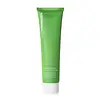What's inside
What's inside
 Key Ingredients
Key Ingredients

 Benefits
Benefits

 Concerns
Concerns

 Ingredients Side-by-side
Ingredients Side-by-side

Water
Skin ConditioningSodium Cocoyl Isethionate
CleansingDecyl Glucoside
CleansingCocamidopropyl Betaine
CleansingGlycerin
HumectantAcrylates Copolymer
Glycol Distearate
EmollientPhenoxyethanol
PreservativeGlycolic Acid
BufferingLactic Acid
BufferingSodium Hydroxide
BufferingCaprylyl Glycol
EmollientEucalyptus Globulus Leaf Oil
PerfumingMentha Piperita Oil
MaskingLaureth-4
EmulsifyingEthylhexylglycerin
Skin ConditioningHexylene Glycol
EmulsifyingMelia Azadirachta Seed Oil
EmollientLinoleic Acid
CleansingCamellia Sinensis Leaf Extract
AntimicrobialChondrus Crispus Extract
Skin ConditioningEucalyptus Globulus Leaf Extract
PerfumingMacrocystis Pyrifera Extract
Skin ConditioningPhytic Acid
Linolenic Acid
CleansingSodium Benzoate
MaskingTocopherol
AntioxidantLimonene
PerfumingWater, Sodium Cocoyl Isethionate, Decyl Glucoside, Cocamidopropyl Betaine, Glycerin, Acrylates Copolymer, Glycol Distearate, Phenoxyethanol, Glycolic Acid, Lactic Acid, Sodium Hydroxide, Caprylyl Glycol, Eucalyptus Globulus Leaf Oil, Mentha Piperita Oil, Laureth-4, Ethylhexylglycerin, Hexylene Glycol, Melia Azadirachta Seed Oil, Linoleic Acid, Camellia Sinensis Leaf Extract, Chondrus Crispus Extract, Eucalyptus Globulus Leaf Extract, Macrocystis Pyrifera Extract, Phytic Acid, Linolenic Acid, Sodium Benzoate, Tocopherol, Limonene
Water
Skin ConditioningCocamidopropyl Hydroxysultaine
CleansingGlycerin
HumectantSodium Lauroyl Sarcosinate
CleansingPEG-150 Pentaerythrityl Tetrastearate
EmulsifyingNiacinamide
SmoothingPEG-6 Caprylic/Capric Glycerides
EmulsifyingSodium Methyl Cocoyl Taurate
CleansingPropylene Glycol
HumectantCeramide NP
Skin ConditioningCeramide AP
Skin ConditioningCeramide EOP
Skin ConditioningCarbomer
Emulsion StabilisingMethylparaben
PreservativeSodium Chloride
MaskingSodium Lauroyl Lactylate
EmulsifyingCholesterol
EmollientDisodium EDTA
Propylparaben
PreservativeCitric Acid
BufferingTetrasodium EDTA
Hydrolyzed Hyaluronic Acid
HumectantPhytosphingosine
Skin ConditioningXanthan Gum
EmulsifyingWater, Cocamidopropyl Hydroxysultaine, Glycerin, Sodium Lauroyl Sarcosinate, PEG-150 Pentaerythrityl Tetrastearate, Niacinamide, PEG-6 Caprylic/Capric Glycerides, Sodium Methyl Cocoyl Taurate, Propylene Glycol, Ceramide NP, Ceramide AP, Ceramide EOP, Carbomer, Methylparaben, Sodium Chloride, Sodium Lauroyl Lactylate, Cholesterol, Disodium EDTA, Propylparaben, Citric Acid, Tetrasodium EDTA, Hydrolyzed Hyaluronic Acid, Phytosphingosine, Xanthan Gum
 Reviews
Reviews

Ingredients Explained
These ingredients are found in both products.
Ingredients higher up in an ingredient list are typically present in a larger amount.
Glycerin is already naturally found in your skin. It helps moisturize and protect your skin.
A study from 2016 found glycerin to be more effective as a humectant than AHAs and hyaluronic acid.
As a humectant, it helps the skin stay hydrated by pulling moisture to your skin. The low molecular weight of glycerin allows it to pull moisture into the deeper layers of your skin.
Hydrated skin improves your skin barrier; Your skin barrier helps protect against irritants and bacteria.
Glycerin has also been found to have antimicrobial and antiviral properties. Due to these properties, glycerin is often used in wound and burn treatments.
In cosmetics, glycerin is usually derived from plants such as soybean or palm. However, it can also be sourced from animals, such as tallow or animal fat.
This ingredient is organic, colorless, odorless, and non-toxic.
Glycerin is the name for this ingredient in American English. British English uses Glycerol/Glycerine.
Learn more about GlycerinWater. It's the most common cosmetic ingredient of all. You'll usually see it at the top of ingredient lists, meaning that it makes up the largest part of the product.
So why is it so popular? Water most often acts as a solvent - this means that it helps dissolve other ingredients into the formulation.
You'll also recognize water as that liquid we all need to stay alive. If you see this, drink a glass of water. Stay hydrated!
Learn more about Water